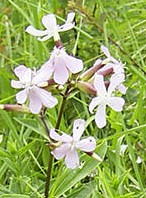 Soapwort goes by many names including bouncing bet, wild sweet william, and latherwort. A member of the carnation family (Caryophyllaceae) it is native to Europe and Asia but has naturalized in eastern North American where it grows in open spaces and waste areas such as along roadways. Soapwort has been grown since medieval times for making soap but also has medicinal and ornamental uses but is invasive and can become a pest.
Soapwort goes by many names including bouncing bet, wild sweet william, and latherwort. A member of the carnation family (Caryophyllaceae) it is native to Europe and Asia but has naturalized in eastern North American where it grows in open spaces and waste areas such as along roadways. Soapwort has been grown since medieval times for making soap but also has medicinal and ornamental uses but is invasive and can become a pest.
Description
Unbranched stems growing one to two feet tall from woody rhizomes are often tinged with red and carry lanceolate leaves up to three inches long on short, broad leafstalks. The pink or whitish fragrant flowers are borne in dense terminal clusters in summer. They have five petals, are about one inch across, and resemble flax flowers. Each flower opens in the evening and remains open for about three days. Plants spread by seed and rhizomes.
Control
To reduce spread by seed remove all flowers as soon as they appear or at least before seed set. The woody rhizome of the plants makes pulling it out of the soil difficult so a trowel or shovel may be necessary to remove them. In severe cases use a nonselective herbicide such as glyphosate (think Roundup) in spring.